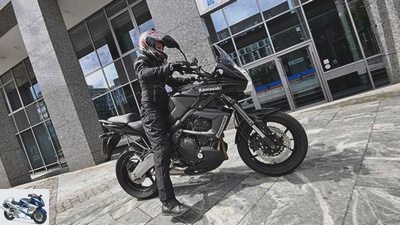Table of contents

Sdun
counselor
workshop
Seat height – motorcycles are getting higher and higher
Guide: driving – seat height
Reduce the seat height in order to be able to drive safely
Motorcycles got not only faster and heavier, but also taller over the years. What some motorcyclist makes beads of sweat on the forehead.
Werner Koch
09/01/2011
The business with upholstered benches and conversion parts for lowering runs like clockwork. “More and more customers are asking for a way to reduce the seat height,” says the long-established motorcycle dealer Herbert Speer from Reutlingen, describing the trend that has been emerging for years. To understand why demand is increasing, just take a look at the MOTORRAD archive. At the beginning of the great motorcycle boom in the early 1970s, nobody had the idea to lower their motorcycle. Why also? On a Honda CB 350, the mid-range motorcycle par excellence, the rider sat just 780 millimeters above the ground, plus the narrow waist of the two-cylinder, which, at 170 kilograms, was child’s play to maneuver.
Even 20 years later, moderate seat heights were the order of the day. In the mid-range machines popular around 1990, the seat height of the Kawasaki GPZ 500, Suzuki GS 500 E and the like was between 770 and 790 millimeters, and the weight was well below 200 kilograms. Even the travel enduro BMW R 100 GS was easy to climb at 850 millimeters.
Nevertheless, there was already the first hesitant demand for a possible lowering of the machine or the seat height. This apparently remained hidden from the marketing experts of the major manufacturers, because up to the year 2000 the seat heights in the segment of popular naked bikes had grown to an average of over 800 millimeters. A trend that has continued unchecked to this day, which is why seat heights of 815 to 840 millimeters have to be climbed with the common everyday models of the 2011 vintage. Anyone who opts for a versatile travel enduro shouldn’t forget the ladder: Seat heights of 850 to 880 millimeters are now standard in this popular segment.
With all due respect, the engineers and designers missed the customer in this regard. Even if the seat height of one or the other model can be varied by repositioning the seat bench, the general trend towards ever taller motorcycles is the wrong way for many shorter riders, especially female riders.
The only thing left for the annoyed two-wheelers to do is to use the means available to lower their machine until they are safe to use when maneuvering and parking; because the high driver’s position doesn’t actually bother with normal driving.
On the contrary: you have a perfect overview of the traffic situation and the route. In addition, the higher focus improves handiness and agility. One of the reasons why the designers shift the overall center of gravity of the machine and the driver’s position upwards, especially for models with wide tires.
The only question that arises is whether that last bit of handiness is so important to normal motorcyclists that they accept the embarrassing and often expensive falling over in the parking lot?
The fundamental problem with high seat heights is the inconvenient leg angle to support the motorcycle while standing or even to maneuver it from a seated position. The longer the legs, the easier the procedure is – and vice versa. For this reason, the general rule for small motorcyclists is that when maneuvering, pushing or turning the motorcycle, you push the motorcycle from the left side and do not try to foot.
Important tip: The motorcycle is easier to maneuver if you don’t keep it balanced with the handlebars, but let the machine fall with light pressure on your hips. From this position you can easily slide over the handlebars and the hip contact without the machine threatening to tip over on the opposite side.
That doesn’t change the fact that stopping at sloping parking lots or in confined spaces becomes a nightmare for some. Then a lowered seating position actually helps enormously. This is primarily due to the fact that the support leg has more power due to the larger side angle to hold the machine in plumb. On the other hand, the center of gravity to be supported decreases, which is also influenced by the weight of the driver.

archive
Travel enduros, such as the Triumph Tiger 800, have a variable seat height.
Simple and inexpensive solutions to reduce the seat height
Adjust spring preload to minimum:
On motorcycles with an adjustable spring preload, this can be used to lower the motorcycle by around ten to 15 millimeters. You change the proportions of positive and negative suspension travel, which are around 30 percent of the total suspension travel when the driver is loaded. With the usual 120 millimeters of total spring travel, this is around 35 millimeters at the front and rear, which can be increased by reducing the preload to around 45 to a maximum of 50 millimeters.
To do this, the threaded spindle on the upper fork plug is simply unscrewed completely. If there is no adjustment option, the spacer sleeve of the spring can be removed after dismantling the fork stopper. This tube, usually made of thin sheet steel, can now be sawn off by the desired amount of around ten to 15 millimeters. Make sure that the cut is made absolutely at a right angle, as otherwise the spring will bulge out to the side due to the inclined contact surface and rub against the inner tube of the fork. Tip: With the help of an evenly attached rubber ring, a straight cut surface can be drawn.
The locked locknuts on the shock absorber are adjusted so that the machine with a driver uses up a maximum of 50 millimeters of the available spring travel. Attention: Before the adjustment, it is essential to mark or measure the standard position of the adjusting rings in order to be able to restore the original position if the result is unsatisfactory. Under no circumstances should the preload be reduced to such an extent that the spring plate lies loosely on the spring when the rear wheel is fully relieved and rebounded. It must absolutely be clamped firmly between the spring and the strut eye with clear tension.
When adjusting using a ratchet mechanism, the smallest position is simply selected.
Effects:
This change lowers the motorcycle almost synchronously without the front or rear wheel hitting the frame-fixed components under maximum load. However, the spring elements tend to bottom out earlier when braking, on hard bumps or when carrying a load. This bottoming out can be prevented at the fork by increasing the oil level.
In addition, the freedom from lean angles and possibly also the handiness of the machine are reduced. If the changes remain within the scope of the standard setting options, no TuV test or clearance certificate is required; an entry in the papers is therefore not necessary.
The above options are primarily recommended for light riders or those riders who move their motorcycle at a leisurely pace and / or are on the move without excessive loads or a pillion passenger.
Lower the front section
In addition to reducing the spring preload, the fork legs can be pushed through upwards, while strictly observing a few specifications, in order to lower the front of the motorcycle a little. To do this, the clamps of the triple clamps and possibly also the handlebar stub must be released on one side. Then the fork leg is pushed through a maximum of ten to 15 millimeters upwards with a twisting movement, and the clamping screws are tightened with the correct tightening torque. Then the same process follows on the other side. The fork protrusion must be exactly the same on both sides.
To ensure that in this position the front wheel does not come into contact with components fixed to the frame when fully compressed, the fork plugs must be unscrewed and the immersion tubes pushed in by the amount of the spring travel (see manual). The minimum distance to components such as radiator, exhaust manifold or fairing must be twelve to 15 millimeters. Pay attention to the kink-free routing of the brake and cable lines.
With upside-down forks, the bars may only be moved over the area in the fork bridges in which they are turned off cylindrically. If the diameter is conical, the clamping effect of the fork bridges is insufficient.
Effects:
When the fork is pushed through, the front section is lowered, which only shifts the seat height down by about half the amount. So ten millimeters fork penetration bring about a five millimeter lower seating position. The steering geometry changes in the direction of handiness (shorter caster, steeper steering head angle), but the lean angle is reduced.
If possible, the fork should only be pushed through in connection with a rear that has been lowered to the same extent in order to maintain the balance and frame geometry of the machine. In general, after every change, the motorcycle should be carefully tried out on a winding, low-traffic route in order to familiarize yourself with the possibly changed cornering behavior and the reduced lean angle, since “hard” components such as side stands or alternator covers now touch down earlier in curves and lever out the motorcycle be able.
Related articles
-
Cook 11 pictures wolf 1/11 The cover and upholstery core need a stable substructure. It’s called a tub, weighs several hundred grams and consists of…
-
Low-rider: bikes for short stature
jkuenstle.de counselor workshop Low-rider: bikes for short stature Tips, tricks and bikes for little riders Low-Rider: Motorcycles for short stature…
-
Second-hand advice for beginners 48 hp motorcycles
Horny 21 pictures Horny 1/21 Thanks to the new driving license regulations, entry into the motorcycle world has become even more attractive. And on the…
-
Tips for buying used motorcycles with over 100,000 kilometers
Herder 21 pictures Lohse 1/21 Aglasterhausen, Ducati ST2, EZ 4/2002, 121,766 km. Lohse 2/21 Actually a tragic case. Ducati is building a famous tourer…
-
Second-hand advice on turbo motorcycles
counselor Used purchase Second-hand advice on turbo motorcycles Second-hand advice on turbo motorcycles Company hot air The heated start to…
-
Motorcycles with cornering ABS in comparison
Photo: fact 28 pictures archive 1/28 BMW took on the pioneering role when it came to the spread of ABS in motorcycles. The following models want to show…
-
Nine 48 hp motorcycles tested for the A2 driver’s license
Jahn 44 pictures Jahn 1/44 Thanks Brussels: With the new tier driving license for young drivers and newcomers, the EU has given a hefty surcharge of 14…
-
Editors’ favorites Used motorcycles
KTM 22nd pictures archive 1/22 Honda VT 500 C: Rest? Relatively far back. Handlebar? Owing to the style of the time. But this engine: still nice to look…
-
125cc motorcycles put to the test
bilski-fotografie.de, Yvonne Hertler 32 pictures bilski-fotografie.de, Yvonne Hertler 1/32 Honda CB 125 R, KTM 125 Duke, Yamaha MT-125, Suzuki GSX-S 125…
-
The best-selling motorcycles of 2008
Jahn motorcycles The best-selling motorcycles of 2008 The best-selling motorcycles of 2008 Five top sellers and their owners Regardless of the market…